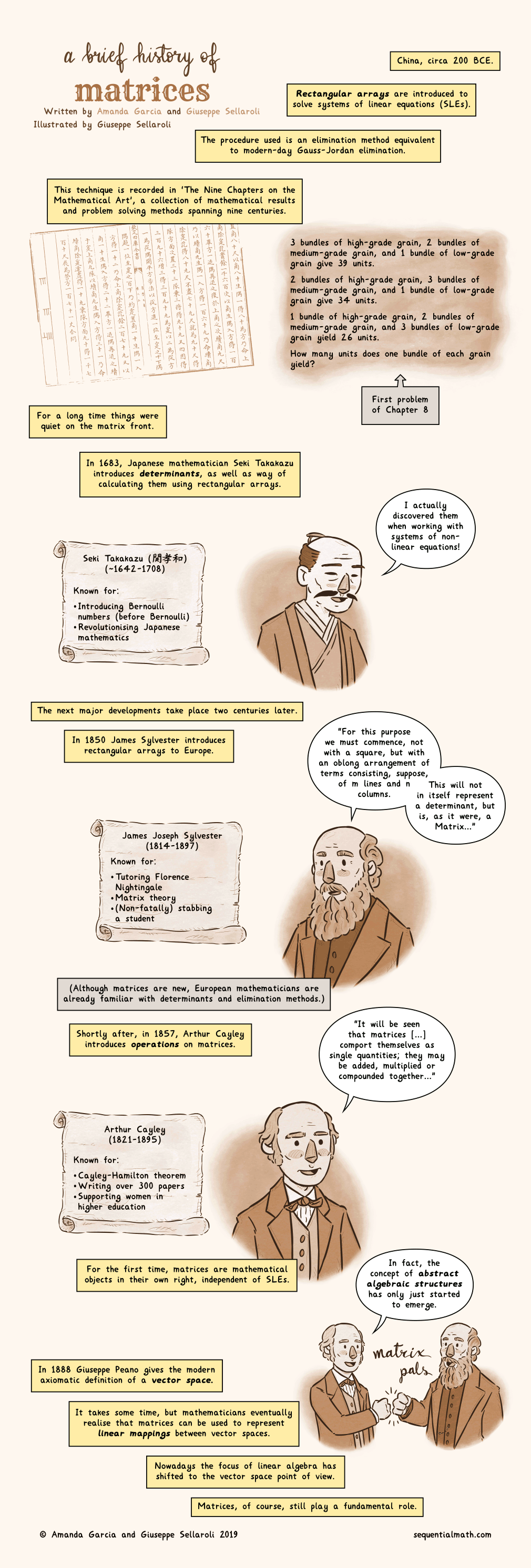March 16, 2019
Some extra historical tidbits that didn't make it into the comic:
- The oldest recorded SLE comes from a Babylonian clay tablet from the 4th century BCE: Two fields have a total area of 1800 square yards. One field produces grain at the rate of 2/3 of a bushel per square yard, while the other produces grain at the rate of 1/2 a bushel per square yard. If the total yield is 1100 bushels, what is the size of each field?
- Seki Takakazu came up with the Newton-Raphson root-finding method before Newton. His mathematical methods were often way ahead of European mathematics.
- Here is an account the stabbing incident involving J.J. Sylvester, as written in a biography of Sylvester written by George Bruce Halsted in The American Mathematical Monthly, Vol. 1, No. 9 (1894), 294-298: "The cause of his sudden abandonment of the University of Virginia the writer has often heard related by the Rev' Dr. R. L. Dabney as follows: In Sylvester's class were a pair of brothers, stupid and excruciatingly pompous. When Sylvester pointed out one day the blunders made in a recitation by the younger of the pair, this individual felt his honor and family pride aggrieved, and sent word to Professor Sylvester that he must apologise or be chastized. Sylvester bought a sword-cane, which he was carrying when waylaid by the brothers the younger armed with a heavy bludgeon. An intimate friend of Dr. Dabney's happened to be approaching at the moment of the encounter. The younger brother stepped up in front of Professor Sylvester and demanded an instant and humble apology. Almost immediately he struck at Sylvester, knocking off his hat, and then delivered with his heavy bludgeon a crushing blow directly upon Sylvester's bare head. Sylvester drew his sword-cane and lunged straight at him, striking him just over the heart. With a despairing howl, the student fell back into his brother's arms screaming out "I am killed"! "He has killed me". Sylvester was urged away from the spot by Dr. Dabney's friend, and without even waiting to collect his books, he left for New York, and took ship hack to England. Meantime a surgeon was summoned to the student, who was lividly pale, bathed in cold sweat in complete collapse, seemingly dying, whispering his last prayers. The surgeon tore open his vest, cut open his shirt, and at once declared him not in the least injured. The fine point of the sword cane had struck a rib fair, and caught against it, not penetrating. When assured that the wound was not much more than a mosquito-bite, the dying man arose, adjusted his shirt, buttoned his vest, and walked off, though still trembling from the nervous shock."
- When Sylvester was named professor of mathematics at Johns Hopkins University, he initially demanded to be paid in gold. His request was denied.
Most of what the characters say is in their own words. Here are the works we cited in order of appearance in the comic.
- Shen, K., J. N. Crossley, and A. W.-C. Lun. The Nine Chapters on the Mathematical Art: Companion and Commentary. New York: Oxford University Press, 1999.
- James Joseph Sylvester, "Additions to the articles in the September number of this journal, “On a new class of theorems,” and on Pascal's theorem", The London, Edinburgh, and Dublin Philosophical Magazine and Journal of Science, 37:251 (1850), 363-370.
- Arthur Cayley, "A Memoir on the Theory of Matrices", Philosophical Transactions of the Royal Society of London, Vol. 148 (1858), 17-37.
- James Joseph Sylvester, "Additions to the articles in the September number of this journal, “On a new class of theorems,” and on Pascal's theorem", The London, Edinburgh, and Dublin Philosophical Magazine and Journal of Science, 37:251 (1850), 363-370.
- Arthur Cayley, "A Memoir on the Theory of Matrices", Philosophical Transactions of the Royal Society of London, Vol. 148 (1858), 17-37.
For more information about about the history of matrices, have a look at the following resources:
- Christine Andrews-Larson, "Roots of Linear Algebra: An Historical Exploration of Linear Systems", PRIMUS, 25:6, (2015), 507-528.
- Israel Kleiner, A History of Abstract Algebra, Birkhäuser Basel, 2007.
- Yoshio Mikami, "On the Japanese Theory of Determinants", Isis, Vol. 2, No. 1 (1914), 9-36.
- J.J. O'Connor and E. F. Robertson, "Matrices and Determinants" (1996).
